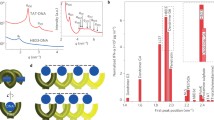Abstract
Peptide T, from the human immunodeficiency virus (HIV), whose sequence is Ala-Ser-Thr-Thr-Thr-Asn-Tyr-Thr, has been shown to inhibit attachment of this virus to T cells and neural cells bearing the CD4 receptor. This peptide shares extensive homology with the 19–26 segment of ribonuclease A (RNase A), whose sequence is Ala-Ala-Ser-Ser-Ser-Asn-Tyr-Cys. Based on comparison of the structures of peptides occurring in proteins of known structure that are homologous to peptide T,viz, RNase A and endothiapepsin and on conformational energy calculations, we predicted that peptide T adopts a structure much like that for residues 19–26 in RNase A. A critical feature is a bend involving residues Thr 4-Asn 7 in peptide T corresponding to Ser 22-Tyr 25 in the RNase A peptide. Our proposed structure for peptide T has recently been confirmed by Cotelleet al. (Biochem. Biophys. Res. Commun. 171, 596–602). We now show directly that the RNase A peptide, with Met replacing Cys 26 to prevent disulfide exchange reactions, strongly induces monocyte-chemotaxis that is blocked by anti-CD4 monoclonal antibody. Both peptide T and RNase A fail to induce chemotaxis, however, in neutrophils which do not express surface CD4 receptors. These results suggest that both peptides interact with the CD4 receptor in inducing monocyte chemotaxis. We have also prepared cyclo-RNase A peptide with Met 26. Using molecular dynamics and conformational energy calculations, we find that the cyclic peptide cannot form a bend structure involving Ser 22-Tyr 25 that is superimposable on the RNase A bend. Indeed, we find that this peptide is inactive in inducing monocyte chemotaxis despite the fact that its amino acid sequence is identical to that of the open chain form. This result suggests that a correlation between the β-bend structure of the RNase A peptide and peptide T and their abilities to bind to the CD4 receptor.
Similar content being viewed by others
References
Blundell, T. L., Sewell, J. A., Jenkins, J. A., and Tickle, I. J. (1981). Brookhaven National Laboratory Protein Data Bank (computer tape).
Boyum, A. (1968).Scand. J. Clin. Lab. Invest. Suppl. 21, 77–89.
Bridge, T. P., Heseltine, P. N. R., Parker, E. S., Eaton, E., Ingraham, L. J., Gill, M., Euff, M., Pert, C. B., and Goodwin, F. K. (1989).Lancet July22, 226–227.
Chen, J. M., Barber, A., Pedersen, J., Brandt-Rauf, P. W., Carucci, J., Murphy, R. B., Carty, R. P., and Pincus, M. R. (1989).J. Protein Chem. 8, 79–86.
Cotelle, N., Lohez, M., Cotelle, P., and Henichart, J. P. (1990).Biochem. Biophys. Res. Commun. 171, 596–602.
Dalgleish, A. G., Beverly, P. C. L., Clapham, P. R., Crawford, D. H., Greaves, M. F., and Weiss, R. A. (1984).Nature (London)312, 763–768.
Davey, F. R., and Nelson, D. A. (1991). InClinical Diagnosis and Management by Laboratory Methods (Henry J. B., ed.), W. B. Saunders, Philadelphia, pp. 677–716.
Hamada, Y., Shibata, M., and Shiori, T. (1985).Tet. Lett. 26, 5155–5158.
Insight II Reference Guide, version 2.0.0, March 1991, Biosym. Technologies, San Diego, California.
Licht, D., Cronstein, B., and Pincus, M. R. (1991).Twelth American Peptide Symposium, Boston, Massachusetts, P-447 (abstract).
Marastoni, M., Salvadori, S., Balboni, G., Spisani, S., Gavioli, R., Traniello, S., and Tomatis, R. (1990).Int. J. Peptide Protein Res. 35, 81–88.
McFadden, D. K., Carlen, P., and Doob, P. E. R. (1991).Twelfth American Peptide Symposium, Boston, Massachusetts, P-459 (abstract).
Merrifield, R. B. (1963).J. Am. Chem. Soc. 85, 2149–2154.
Nemethy, G., Pottle, M., and Scheraga, H. A. (1983).J. Phys. Chem. 87, 1883–1887.
Schiffmann, E., Corcoran, B. A., and Wahl, S. M. (1975).Proc. Natl. Acad. Sci. USA 72, 1059–1062.
Pert, C. B., Hill, J. M., Ruff, M. R., Berman, R. M., Robeg, W. G., Arthur, L. O., Ruscetti, F. W., and Farrar, W. L. (1986).Proc. Natl. Acad. Sci. USA 83, 9254–9258.
Pincus, M. R., Carty, R. P., Chen, J. M., and Murphy, R. B. (1987).Biochem. Biophys. Res. Commun. 143, 248–251.
Pincus, M. R. (1992).Biopolymers (in press).
Ruff, M. R., Hallberg, P. L., Hill, J. M., and Pert, C. B. (1987a).Lancet Sept. 26, 751.
Ruff, M. R., Martin, B. M., Ginns, E. J., Farrar, W. L., and Pert, C. B. (1987b).FEBS Lett. 211, 17–22.
Shah, D., Chen, J. M., Carty, R. P., Pincus, M. R., and Scheraga, H. A. (1989).Int. J. Peptide Protein Res. 34, 325–332.
Sodorowski, J., Kavalaski, M., Tatanya, D., Basiripour, L., Rosen, C., and Haseltine, W. (1987).Lancet June 20, 1428.
Warme, P. K., Momany, F. A., Rumball, S. U., Tuttle, R. W., and Scheraga, H. A. (1974).Biochemistry 13, 768–782.
Wlodower, A., Miller, M., and Sjolin, C. (1982).J. Biol. Chem. 257, 1325–1332.
Author information
Authors and Affiliations
Rights and permissions
About this article
Cite this article
Licht, D., Cronstein, B., Dykes, D.C. et al. Correlation of the conformation of a modified ribonuclease octapeptide, homologous to peptide T, with its ability to induce CD4-dependent monocyte chemotaxis. J Protein Chem 11, 475–481 (1992). https://doi.org/10.1007/BF01025024
Received:
Published:
Issue Date:
DOI: https://doi.org/10.1007/BF01025024




